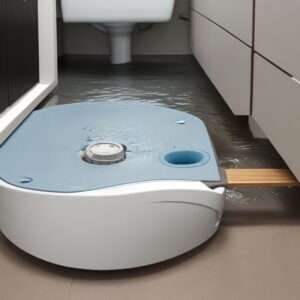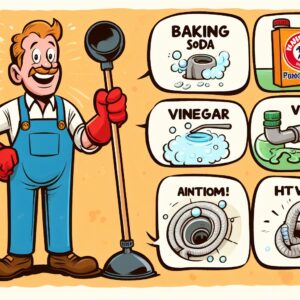The inconvenience of a clogged drain is all too common in households around the world. Traditional solutions often reach for chemical drain cleaners, but these can pose serious risks to your health, plumbing, and the environment. They contain harsh substances that can erode your pipes over time and introduce toxic materials into waterways.
Why Avoid Chemical Drain Cleaners?
The use of chemical drain cleaners often seems like a straightforward solution when faced with the common dilemma of clogged pipes. Reaching for that bottle of powerful cleaner can initiate a cascade of negative effects that extend far beyond the immediate clearing of a blockage.
These chemical formulations typically contain lye (sodium hydroxide) or sulfuric acid as their active ingredients—substances chosen for their ability to quickly dissolve organic matter. Yet, this rapid dissolution comes at a cost. The high reactivity of these chemicals means they can also react with the material of the pipes themselves, leading to corrosion. Over time, this can weaken pipes, causing leaks, warping, or even ruptures, introducing the need for expensive plumbing repairs or full replacement, particularly in homes with older plumbing or pipes made from less resilient materials.
Homes that are serviced by septic systems must be especially cautious. Chemical drain cleaners can disrupt the bacterial balance within the septic tank—these bacteria are crucial for breaking down and treating waste before it percolates into the soil. By destroying these bacteria, the cleaners can cause system malfunction, which is not only a public health hazard but also an environmental concern and a significant financial burden to rectify.
The risks associated with chemical drain cleaners also extend to personal safety. Accidental skin contact with these products can result in severe chemical burns, necessitating medical attention. Inhalation of the fumes they produce can irritate the respiratory tract, leading to discomfort, coughing, and in severe cases, long-term respiratory issues. Households with children and pets are at an increased risk, as these populations are more susceptible to accidental poisoning.
After their use, remnants of these chemical cocktails invariably find their way into municipal water systems or local environments. Water treatment plants are not always equipped to fully neutralize such substances, resulting in the possible release of these hazardous chemicals into rivers, lakes, and oceans where they can harm aquatic life and disrupt ecosystems. This pollution cycle can ultimately impact human health as well, as these toxins enter food sources and drinking water supplies.
By exploring gentler alternatives, homeowners can effectively manage clogs and maintain their plumbing systems without compromising the structural integrity of their piping, damaging delicate environmental processes, or putting their family’s health at risk. Natural solutions often make use of common household items, which are not only safer but are also more economical and readily available.
Foregoing chemical drain cleaners in favor of these more benign approaches contributes to a sustainable lifestyle. It preserves the functionality and longevity of home plumbing systems, supports the delicate balance of septic systems, and protects both the environment and our personal health. With the potential perils of chemical cleaners weighing heavily against their convenience, the move to greener, safer methods is clearly the responsible choice for conscientious homeowners.
Prevention The First Step

The old adage “an ounce of prevention is worth a pound of cure” never more true than when it comes to maintaining clog-free drains. Exercising a little caution with what you allow down your drains can save you a significant amount of time, money, and hassle associated with unclogging them later on.
Being vigilant with waste disposal is paramount. Cooking oils and fats are a common cause of kitchen sink blockages as they can solidify within the pipes, catching other debris and forming stubborn clogs. It is best to dispose of these substances in the trash rather than rinsing them away. Coffee grounds and food scraps should follow the same route; despite being organic, they don’t break down quickly and can easily accumulate, obstructing water flow. In bathrooms, hair, soap scum, and small objects are often the culprits of blockages; they are better caught in waste bins than left to navigate the piping.
The implementation of simple tools such as drain strainers or sink guards can have a substantial impact. These devices are designed to catch solids that can contribute to clogs while allowing water to flow freely. They come in various sizes and styles to fit different drains and can be easily cleaned—a small effort in exchange for avoiding a potentially troublesome clog.
Regular maintenance is critical in the fight against accumulated residue. A weekly flush of hot water can work wonders in dislodging early-stage buildup before it becomes a problem. The heat from the water helps to melt away fatty substances and move loose material through the pipes. For added preventative care, pouring a mixture of hot water, baking soda, and vinegar down the drains can help to clear any developing obstructions and neutralize foul odors.
Preventative practices don’t only apply to the internal plumbing. Keeping an eye on the external drainage systems, such as gutter downspouts and outdoor drains, ensures that they are not blocked by leaves, dirt, or other external debris. These blockages can lead to water backing up, which might then find its way into your home.
Instituting a proactive approach to drain care is an investment in the health and longevity of your home’s plumbing system. By strategically monitoring and managing what goes down the drain, employing simple tools like strainers, and committing to regular flushing, you can reduce the likelihood of clogs significantly. Not only does this preventative stance protect your pipes, but it also helps create a more secure and efficient household, minimizing the need for reactive measures that often come with greater inconvenience and cost.
Manual Removal Techniques
When faced with a clogged drain, reaching for manual tools can be an effective first line of defense. Two common instruments in the homeowner’s arsenal are the plunger and the plumbing snake, also known as a drain auger. Both can be used to clear blockages without chemicals or professional help when used correctly.
Plunging is a technique that most people are familiar with, but there’s a proper way to do it for maximum effectiveness. You must prepare the sink by ensuring there is enough water to submerge the plunger’s cup completely. This water is necessary to create the hydraulic pressure that will dislodge the clog. With the plunger over the drain, press down firmly to form a tight seal, and then use a forceful, pumping motion. The goal here is to use the pressure created by pushing and pulling water in the pipes to loosen the clog. It may take a number of vigorous plunges before the blockage is cleared, so persistence is key. If there’s more than one drain opening (like in a double sink), cover the other one with a wet cloth to ensure full pressure is directed at the clog.
For tougher blockages that a plunger can’t handle, a plumbing snake can be used to reach deeper into the pipe. Begin by slowly feeding the coiled metal wire of the snake into the drain until you encounter the clog. You may need to adjust your grip and apply gentle pressure to advance the coil. Once the head of the snake is at the clog, rotate the handle, which will in turn spin the coiled end inside the drain. This action either breaks up the clog or hooks onto the debris so it can be extracted. When you feel the resistance lessen, slowly pull the snake out of the drain, bringing the debris with it. After removing the material, run hot water down the drain to clear any remnants of the blockage.
Both plunging and plumbing snakes are manual methods that require a bit of physical exertion, but they are environmentally friendly and generally safe for your plumbing. Having these tools on hand and knowing how to use them effectively can save you from the frustration of clogs and the cost of hiring a plumber for minor issues. It’s important to recognize their limitations. If the clog persists after several attempts with these tools, it may be time to call a professional to address the blockage to avoid causing damage to your pipes.
Natural Remedies for Unclogging Drains

Boiling Water Technique: carefully pour boiling water down the drain in two to three stages, allowing the hot water to work between each pour.
Baking Soda and Vinegar: pour half a cup of baking soda followed by half a cup of vinegar into the drain. Cover the drain to contain the reaction, wait 15 minutes, and then flush with hot water.
Salt and Baking Soda: mix half a cup of table salt with half a cup of baking soda and pour into the drain. Leave it overnight and flush with boiling water in the morning.
Dish Soap and Hot Water: for greasy clogs, pour a quarter-cup of dish soap down the drain, followed by a pot of boiling water to cut through the grease.